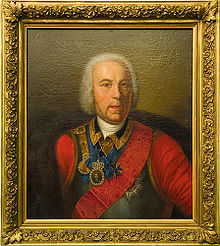Georg Wilhelm Henning
Georg Wilhelm Henning ( Russian Георг Вильгельм де Геннин ) (born October 11, 1676 in Siegen , † April 12, 1750 in St. Petersburg ) was a German-Russian engineer, designer, officer and organizer.
Life
Georg Wilhelm Henning came from Siegerland and was baptized in Siegen in 1676 . His family later moved to Hanau , which is why Henning was sometimes referred to as Hanauer. Henning started his apprenticeship in a Siegen iron foundry. a. Made guns. He moved to Amsterdam and served in the Dutch army in the maintenance of artillery.
Tsar Peter I , who wanted to modernize Russia and to do so traveled Europe and looked for specialist staff, became aware of Henning in Amsterdam in 1698. Henning was taken into Russian service by François Le Fort and changed his name to Gennin, which is easier to pronounce in Russian.
Gennin took part in the Great Northern War with the Imperial Russian Army . He distinguished himself u. a. at the siege of Vyborg and the siege of Kexholm . Gennin frequented the highest circles at the Russian court and came into contact with Jacob Daniel Bruce and Alexander Danilowitsch Menshikov . In the following years, Gennin served as a geological advisor in the redesign of the mining industry in Russia and in 1721 was commissioned to build an arms factory in Sestrorezk .
Together with his colleague Vasily Nikititsch Tatishchev , Georg Gennin was also the founder of the city of Yekaterinburg , which developed around the ironworks established there. Its official founding date was November 18, 1723. In 1734 he returned to St. Petersburg, where he was a member of the military council for life.
He died on April 12, 1750 in St. Petersburg , where he was also buried. Gennin left a considerable fortune to his two sons.
Trivia
In 2012, the photographer Thomas Kellner traveled to Russia on behalf of RWE to photograph Henning's industrial architecture in Yekaterinburg and Perm ( Genius Loci ). The factories founded by Henning processed steel and metal. Kellner not only took photos on site in Russia, but also in the surrounding area of Siegen in order to capture the connection between the two regions in the processing of steel and metal.
Honors
In 1730 he was raised to the nobility.
Publications
- Описание Уральских и Сибирских заводов , 1735, contains the first detailed scientific description of the Perm region
literature
- Erik Amburger : History of the organization of the authorities in Russia from Peter the Great to 1917. 1966
- Erik Amburger: Recruiting foreign skilled workers for the economy of Russia from the 15th to the 19th century. 1968
- German Gender Book, Volume 208 p. 18
- Thomas Kellner (Ed.): Genius Loci: Two Siegener im Zarenland . Seltmann and Sons, Lüdenscheid; Berlin 2014, ISBN 978-3-944721-02-6 .
Individual evidence
- ↑ Art meets technology. In: www.rwe.com. November 24, 2014, accessed May 3, 2020 .
| personal data | |
|---|---|
| SURNAME | Henning, Georg Wilhelm |
| ALTERNATIVE NAMES | Геннин, Георг Вильгельм де (Russian) |
| BRIEF DESCRIPTION | German-Russian engineer, designer, officer and organizer |
| DATE OF BIRTH | October 11, 1676 |
| PLACE OF BIRTH | Wins |
| DATE OF DEATH | April 12, 1750 |
| Place of death | St. Petersburg |
